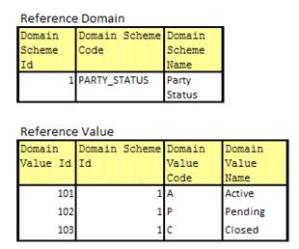This is the second article in the series on working with reference domains, also commonly referred to as classifications. In Part I, we looked at the nature of classifications. Here we will discuss designing structures to accommodate them in the EDW’s Information Warehousing layer, within the normalized System of Record.
This is the second article in the series on working with reference domains, also commonly referred to as classifications. In Part I, we looked at the nature of classifications. Here we will discuss designing structures to accommodate them in the EDW’s Information Warehousing layer, within the normalized System of Record.
- Put each reference domain of values into its own table.
- Collect all reference domains into two tables; one for a master set of domains and the other for all the values, with a column linking each to the relevant domain.
The second approach is the recommended one, and the remainder of this article will present the design and the rationale. I have seen the consolidated reference data approach implemented many times within the System of Record of the EDW; and it has proved highly effective.
- Reference Domain
- Reference Value
As mentioned in Reference Domains Part I, reference domains are commonly made up of pairs of code and description attributes. However, it is possible that some domains may be comprised of additional attribution, such as short names, long names, multi-language names etc. In such cases, consideration should be given to extending the model to accommodate additional fields. (This is not the same as related reference values that may be stored together in the source, but should be separated in the EDW.)
The domain values may be organized hierarchically. To support many-to-many relationships between domain values, in terms of hierarchies or other relationship types, the associative entity, Reference Value to Reference Value Relationship, should be used. As with all associatives, it will accommodate multiple concurrent as well as historical relationships.
The history of values for a given scheme in relationship to other core concepts is to be retained within relevant associative structures.
To illustrate the example more fully, consider the following:
The Domain Scheme and Domain Value tables contain rows for the Party Status domain scheme.
Day 1
On day one, the party enters the system with a party status of “Active”. There are no entries in the Party to Domain Relationship table.
The following points outline the benefits of employing a consolidated set of domain schemes and values within a small set of tables, versus creating a separate table for each domain scheme’s set of values.
- Data Integrity: The integrity of the allowable set of values within a given domain are maintained through the application logic defined and implemented through the ETL. Maintaining a master list reduces the chance of inconsistencies or the appearance of anomalies.
- Flexibility: There is only one table to access for all domain value codes and descriptions within the SOR.
- Implementation Efficiency: No additional database entities or tables to be created, tested or maintained within the System of Record (SOR) logical or physical model. Fewer objects means less chance for error.
- Operational Efficiency: A single utility can be created to interface with this table. It is true that even with multiple tables a single utility could be created with minimal logic. However, each new object would require some changes to the application, whereas the consolidated version can be extended seamlessly.
- Consistency: History is stored in the classification associative tables (e.g., Party to Domain Relationship). The retention of the domain schemes and values as surrogate keys in the Domain Value entity facilitates these structures. This allows history to be gathered using a common mechanism, explicitly identifying both the scheme and the value.
In part three, we will go on to look at collecting and documenting classifications.









